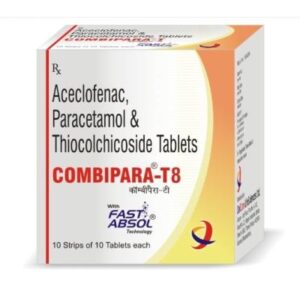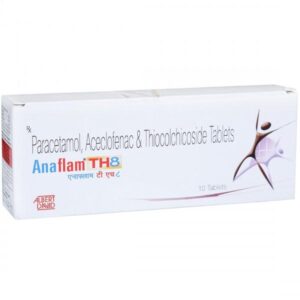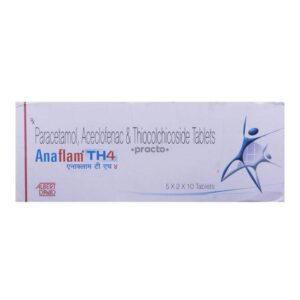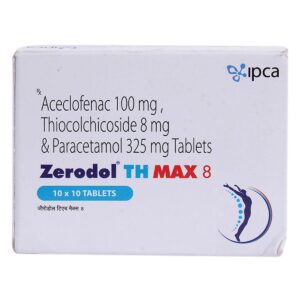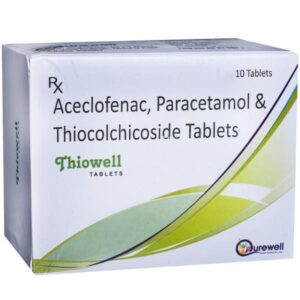PARACETAMOL (ACETAMENOPHEN) + ACECLOFENAC + THIOCOLCHICOSIDE
Paracetamol (acetamenophen): Paracetamol, also known as acetaminophen, is a medication commonly used for pain relief and reducing fever. It is available over-the-counter and by prescription in various strengths.
Mechanism of Action:
The exact mechanism of action of paracetamol is not fully understood. It is believed to work by inhibiting the synthesis of prostaglandins in the central nervous system, thereby reducing pain and fever. It is also thought to have minor anti-inflammatory effects.
Use:
Paracetamol is primarily used to relieve mild to moderate pain, such as headaches, muscle aches, toothaches, and menstrual cramps. It is also commonly used to reduce fever associated with various illnesses, including colds and flu. Additionally, it may be used to alleviate pain associated with osteoarthritis or rheumatoid arthritis.
Dose:
The recommended adult dose of paracetamol is typically 500 to 1000 milligrams (mg) taken every 4 to 6 hours, not exceeding a total of 4000 mg in 24 hours. For children, the dosage is weight-based and is usually given in a liquid form or chewable tablet.
Side Effects:
Paracetamol is generally considered safe when taken at recommended doses. However, it can cause side effects in certain individuals. Some common side effects include nausea, vomiting, and stomach upset. In rare cases, it may cause allergic reactions, skin rash, or liver damage, especially if taken in excessive amounts or combined with alcohol. An overdose of paracetamol can be potentially fatal and may lead to liver toxicity.
It is important to note that individuals with certain medical conditions, such as liver disease or alcoholism, should use paracetamol with caution and under the guidance of a healthcare professional. Additionally, it is essential to read and follow the recommended dosage instructions and consult a healthcare provider if symptoms persist or worsen.
Aceclofenac: Aceclofenac is a nonsteroidal anti-inflammatory drug (NSAID) used to relieve pain and inflammation in conditions like rheumatoid arthritis, osteoarthritis, ankylosing spondylitis, and acute gout. It belongs to the class of drugs known as selective COX-2 inhibitors.
The mechanism of action of Aceclofenac involves inhibiting the production of prostaglandins, which are chemicals responsible for pain, inflammation, and fever. It specifically inhibits the enzyme cyclooxygenase (COX-2), which is responsible for the production of prostaglandins at the site of inflammation.
The recommended dose of Aceclofenac is typically 100 mg to 200 mg per day, divided into one or two doses. It is preferable to take it with food or after meals to minimize gastrointestinal side effects.
Common side effects of Aceclofenac may include abdominal pain, indigestion, nausea, diarrhea, dizziness, headache, and skin rash. Gastrointestinal side effects are more common with Aceclofenac compared to some other NSAIDs. In rare cases, it may lead to serious allergic reactions, liver damage, or kidney problems. Therefore, it is essential to use this drug under the supervision of a healthcare professional and to report any concerning side effects immediately.
As with any medication, it is important to discuss the risks and benefits of Aceclofenac with a healthcare provider before starting treatment. They can determine if it is appropriate for your specific condition and provide guidance on proper dosing and monitoring for side effects.
Thiocolchicoside: Thiocolchicoside is a muscle relaxant drug that is primarily used to relieve muscle spasms and stiffness. It is commonly prescribed for conditions such as back pain, neck pain, and musculoskeletal disorders.
The mechanism of action of Thiocolchicoside involves its ability to enhance the release of gamma-aminobutyric acid (GABA), which is an inhibitory neurotransmitter in the central nervous system. This leads to the suppression of neuronal excitability, resulting in muscle relaxation and relief from muscle spasms.
Thiocolchicoside is available in oral tablet or capsule form and is typically taken 8-16 mg per day in divided doses. The dosage may vary depending on the severity of the condition and the individual’s response to the medication. It is important to follow the prescribing doctor’s instructions and not exceed the recommended dose.
Like all medications, Thiocolchicoside can cause side effects. Common side effects include drowsiness, dizziness, headache, nausea, and gastrointestinal discomfort. Some individuals may also experience allergic reactions such as rash, itching, or swelling. If any severe or persistent side effects occur, it is crucial to seek medical attention immediately.
Thiocolchicoside is generally well-tolerated, but it is important to note that it may cause drowsiness and impair cognitive and motor functions. Therefore, it is advised to avoid activities requiring mental alertness, such as driving or operating machinery, while taking this medication.
It is essential to consult a healthcare professional or pharmacist before starting Thiocolchicoside to ensure its appropriateness and safety, particularly if an individual has a history of allergic reactions, liver or kidney problems, or if they are taking other medications that may interact with Thiocolchicoside.

